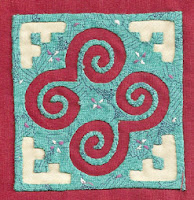Spring Animals – Embroideries from
the 1930’s
Well, it is spring here, at least in
Santa Fe. Hopefully, soon the nice
weather will reach you also, although I can remember, living in New England,
snow packs until May.
So to celebrate the season I have selected
several children-themed embroideries from the 1930’s.
This is a feedsack, technically, the
more correct name would be “textile bag”, which as you can see by the remaining
lettering, contained dried beans.
Textile bags were used as packaging for every imaginable dry item, from
flour and sugar to voting ballots and ammunition. Ultimately, following WWII the paper bag manufacturers managed to
supplant the cloth bag industry by deeming their bags “unsanitary”, although
other countries continued to use this packaging. During the peak of textile bag use various producers of goods
vied for customers and used their packaging to encourage sales. During the depression it was a bonus if your
flour sack could also be used as fabric for curtains or a child’s dress or
patches for a quilt. Often small bags
were imprinted with designs for embroidery.
As you can see, one of the disadvantages of using such cloth for décor was
the label printing that often remained despite repeated washings.
These two matted embroideries were, perhaps, patches from an embroidered child's spread or pillow cover.
This is an embroidered sham for a child's pillow.
Small pieces of vintage embroidery can be readily found in thrift stores and on-line. They add great charm to any child's room.







































